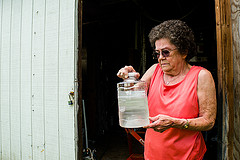Climate Resilience

Durham faces increasingly severe impacts from weather- and climate-related threats, as well as from stressors unrelated to climate, such as rapid population growth, continued development, and shifts in economic and demographic trends.
Durham is already experiencing these effects and is expected to experience increased vulnerability & risk in these key areas:
- Impact of flooding on properties & road access
- Impact of minor flooding on all infrastructure
- Impact of water shortage on water supply
- Impact of extreme heat on residents
- Impact of wildfire on residential properties

Climate Impacts on Health
Durham was the first county in North Carolina to include a chapter on climate change and public health in its Community Health Assessment and continues to recognize the severe public health issues related to climate change, reflected in revisions of the Assessment. The most updated 2023 Community Health Assessment is now available to the public. Please navigate to Chapter 11: Environmental Health & Climate Change (page 226) and see the three sections recognizing the top severe public health issues related to climate change, included below:
Please also visit our pages on the public health effects in Durham of these top climate risks:
To learn more about resilience in the Triangle Region of North Carolina (Durham, Orange, and Wake counties), please see the Triangle Regional Resilience Assessment.



